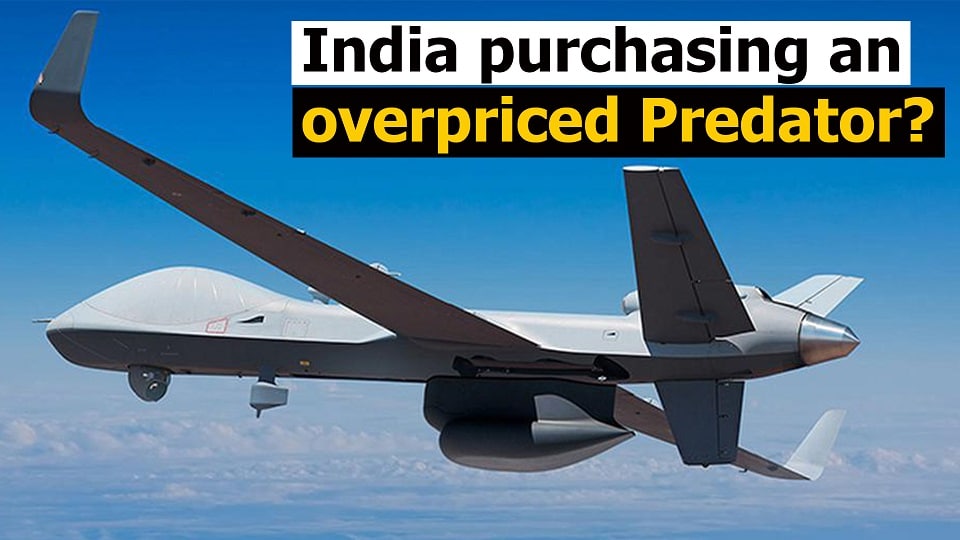Aerospace
Is India purchasing overpriced MQ-9B Predator Drones from the United States?

India acknowledges the purchase of a new unmanned aerial vehicle (UAV) for Indian Defence, which might be used to patrol borders and protect territory in emergency situations. According to a recent report, the Praedtor is being criticized for the excessive amount which India is planning to pay. We shall learn the rationale behind this UAV’s exorbitant cost in this video.
India is currently developing 5 UAVs that it plans to use in the future.(Opens in a new browser tab)
The characteristics of a UAV are similar to those of a fighter jet but without a pilot inside. Instead, it is entirely controlled from the ground using a satellite navigation system. Drones are used to identify ground reports from remote locations and to detect enemy activity using infrared cameras and other cutting-edge sensors.
India to buy 31 Predator drones from the US for $3.5 bn(Opens in a new browser tab)
The MQ 9B American drone marine guardian UAV can fly up to 40,000 feet and has a 30-hour endurance. The sea guardian has a maximum range of 5,000 nautical miles and an airspeed of 210 KTAS. Additionally, the exterior cargo capacity is 2,155 kg with 9 external hardpoints, while the interior payload capacity is 363 kg. Around 5,670 kg is the drone’s maximum takeoff weight.
India’s $3 Billion MQ-9 Reaper Drones Deal With US In Advanced Stage(Opens in a new browser tab)
Up to 31 of these drones will be purchased by India for the price of 99 million dollars each. Other nations have bought conventional drones of the same sort, which may cost up to 55 million dollars, but they are devoid of any sophisticated features.
Given that technology has improved and that more services might be required in the future, these drones are pricey. Indian UAVs could now operate more conveniently thanks to new technologies. Additionally, this would be equipped with Indian-made missiles and an aircraft system.
Engines, radar processor units, avionics, sensors, and software are just a few of the major parts and subsystems that will be made in or imported from India. The USA is willing to give away 15–20% of the technology transfer.
India’s military forces will be able to monitor the nation’s land and maritime borders thanks to these drones.
Two MQ-9B Sea Guardian drones were leased by the Indian Navy from General Atomics for a year to be used for surveillance in the Indian Ocean. After that, the lease’s term was extended.
Indian Defence may increase its reliance on external monitoring to better secure the country. These drones will be used near the border between Pakistan and China primarily for activity observation. The 30-hour endurance may serve as extra support for successful strategies.

Aerospace
Boeing Transfers Rocket Stage to NASA, Paving Way for Human Moon Mission

Boeing has achieved a significant milestone by providing NASA with the second core stage of the Space Launch System (SLS) rocket.
This crucial component, crafted at NASA’s Michoud Assembly Facility (MAF), is set to propel the Artemis II crew into lunar orbit, marking humanity’s return to deep space after a 50-year hiatus.
The monumental Boeing-built rocket stage, the largest element of the Artemis II mission, will embark on a journey aboard the Pegasus barge, traveling 900 miles to NASA’s Kennedy Space Center.
Comparison of two legendary aircraft B777x vs B747 aircraft:Click here
Upon arrival, it will be meticulously integrated with other essential Artemis II components, including the upper stage, solid rocket boosters, and NASA’s Orion spacecraft within the iconic Vehicle Assembly Building. This intricate integration process is a vital step toward the eagerly anticipated Artemis II launch, slated for 2025.
“Boeing-built products helped land humankind on the moon in 1969, and we’re proud to continue that legacy through the Artemis generation,” remarked Dave Dutcher, vice president and program manager for Boeing’s SLS program. “Together, with NASA and our industry partners and suppliers, we are building the world’s most capable rocket and paving the way to deep space through America’s rocket factory in New Orleans.”
NASA, Lockheed Martin Reveal X-59 Quiet Supersonic Aircraft:Click here
The delivery of Core Stage 2 marks a significant achievement in the evolution of the SLS rocket. Towering over 200 feet and powered by four RS-25 engines, this core stage, coupled with two solid-fueled booster rockets, will generate a staggering 8.8 million pounds of thrust. This immense power is crucial to launching Artemis II and future missions into the vast expanse of space.
The SLS rocket stands unparalleled in its capability to transport both crew and substantial cargo to the moon and beyond in a single launch. Its extraordinary capacity will facilitate the delivery of human-rated spacecraft, habitats, and scientific missions to destinations including the moon and Mars, ushering in a new era of space exploration.
-

 Travel1 week ago
Travel1 week agoAir India to Expand US Operations with Three New Routes After a Decade
-

 Travel2 weeks ago
Travel2 weeks agoWhy We Should Avoid These Stamps in a Passport
-

 Airlines1 month ago
Airlines1 month agoInvestigations Reveal Fake Chinese Titanium in Boeing and Airbus Jets
-

 Tech4 weeks ago
Tech4 weeks agoChina’s CATL Plans 1,800-Mile Electric Plane Launch by 2027
-

 Airport3 days ago
Airport3 days agoTop 10 Largest Airports in the World by Size
-

 Aerospace4 weeks ago
Aerospace4 weeks agoChina’s Fighter Jets Turn Wings into Autonomous Drones
-

 Airlines4 days ago
Airlines4 days agoAir India Rolls Out A350s for Delhi-New York JFK and Newark Routes
-

 Defence3 weeks ago
Defence3 weeks agoBoeing Enhances Chinook with New Engines and Block II Upgrades at $96 Million







